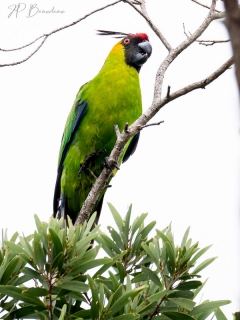Horned Parakeet |
|
|
Also known as: Crested Parakeet
Photos
View in GalleryDid You Know?
The Horned Parakeet is so named because of the two elongated feathers that are in the crown of its head; in the male they measure 3" and are longer and wider than in the female.Programs & Projects
WPT has worked with numerous partners to help save this species. Learn moreAcademic Research
Related publications: Eunymphicus cornutusSpecies Profile
Genus: Eunymphicus | Species: cornutus
Size:
32cm (12.5 in)
Weight:
140g (5 oz)
Subspecies including nominate:
one
Colour Adult:
Both adults yellow ear coverts and hindneck; red forehead and forecrown; black face and lores; black elongated crest feathers tipped with red; green/yellow rump; green tail washed with blue. Bill pale blue/grey tipped with black. Eye orange/red.
Colour Juvenile:
Markings on face grey and less extensive; black forehead and forecrown, the feathers tipped with red; pale green ear coverts. Bill horn in colour. Eye brown.
Call:
Calls made in flight are described as raucous and abrupt; chuckling notes while perched. Sharp shrieks when alarmed.
Listen NowVideo Links:
Video 1 | Video 2 | Video 3More Information:
Content Sources:
CITES
BirdLife International
Cornell Lab of Ornithology/Birds of the World
A Guide to Parrots of the World, Juniper and Parr, 1998
Parrots of the World, Forshaw and Cooper, 1977.
Vanished and Vanishing Parrots, Forshaw, 2017.
Parrots of the World, Forshaw, 2006.
Lexicon of Parrots, Thomas Arndt.
Parrots in Aviculture, Low, 1992.
Parrots: Status Survey and Conservation Plan 2000-2004, Snyder, McGowan, Gilardi, Grajal, 2000.
Photos
View in GalleryDid You Know?
The Horned Parakeet is so named because of the two elongated feathers that are in the crown of its head; in the male they measure 3" and are longer and wider than in the female.Programs & Projects
WPT has worked with numerous partners to help save this species. Learn moreAcademic Research
Related publications: Eunymphicus cornutusSpecies Care
Captive Status:
Rare
Longevity:
Not recorded.
Housing:
Walk-in enclosure minimum length 4.5m (14.7 ft).
Diet:
Small seed mix such as: canary, oats, safflower and a little hemp; spray millet; limited sunflower seed, dry, soaked or sprouted; sprouted pulses such as mung beans, cooked butterbeans and lentils; boiled maize; green leaves such as: Swiss chard, lettuce, sowthistle, dandelion, chickweed; vegetables such as: carrot, corn, celery, zucchini, squash, green beans and peas in the pod; fruits such as: apple, pear, oranges, bananas, cactus fruits, pomegranate; nuts such as: hazelnuts (lightly cracked), pecans and roasted peanuts; complete pellet.
Enrichment:
Provide overhead misters or shallow bathing bowls, puzzle/foraging toys, swings, ladders, ropes, noise makers and bird-safe chewable wood or vegetable tanned leather toys. Place multiple perches throughout spacious aviary.
Nest Box Size:
Vertical box 8" x 8" x 18" (20.3cm x 20.3cm x 45.7cm).
Clutch Size:
3-4
Incubation Time:
22 days
Fledging Age:
5 weeks
Hatch Weight:
6g (0.2 oz)
Peak Weight:
Not recorded.
Weaning Weight:
Not recorded.
Photos
View in GalleryDid You Know?
The Horned Parakeet is so named because of the two elongated feathers that are in the crown of its head; in the male they measure 3" and are longer and wider than in the female.Programs & Projects
WPT has worked with numerous partners to help save this species. Learn moreAcademic Research
Related publications: Eunymphicus cornutusSpecies Wild Status
World Population:
8000-9000
IUCN Red List Status:
Vulnerable
CITES Listing:
Appendix I
Threat Summary:
A BirdLife “restricted-range” species. Has severely declined since the 1880s due to forest loss and the wildlife trade. This species may also be threatened by predation from introduced cats and rats.
Range:
Grande Terre, New Caledonia.
Habitat:
Found mainly above 450m (1476 ft) in humid indigenous forests, secondary growth and savanna woodland. Also occurs in mixed Agathis-Araucaria forest.
Wild Diet:
Feeds on flowers, nuts, fruits, berries of vines; seeds of various trees and shrubs, notably “penubre tree”, Agathis lanceolata, Lantana camara and Carica papaya.
Ecology and Behaviour:
Are wary and mostly unapproachable. Are generally seen in pairs and small, noisy groups of up to 10 birds. Birds roost in the treetops or in hollows, becoming active an hour before sunrise.
Clutch and Egg Size:
3-4 rounded eggs, 26.5 x 21.5mm (1 x 0.8 in).
Breeding Season:
September-March; nest is in cavity of dead or living tree trunks, sometimes on the ground.
Related Links:
Wikipedia
Research: Morphological, behavioural and genetic differentiation with the Horned Parakeet...
Photos
View in GalleryDid You Know?
The Horned Parakeet is so named because of the two elongated feathers that are in the crown of its head; in the male they measure 3" and are longer and wider than in the female.Programs & Projects
WPT has worked with numerous partners to help save this species. Learn moreAcademic Research
Related publications: Eunymphicus cornutusMembers Only Resources
Please log-in now to find more research, resources and tools.
Not a Member?
Find more great information:
Gain exclusive access to 600+ pages of additional research, seminars and podcasts, specialists to ask your toughest questions, and dozens of other fun resources - when you become a WPT member.
Join Today >>

































